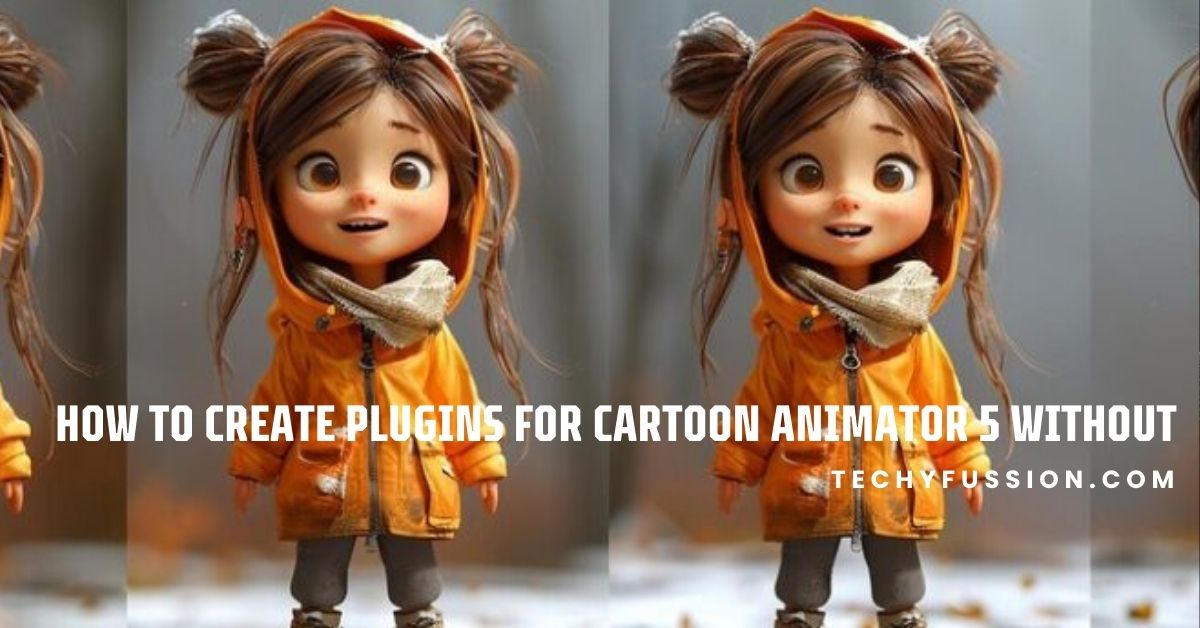How to Create Plugins for Cartoon Animator 5 Without: A Step-by-Step Guide
Creating plugins for Cartoon Animator 5 (CA5) can open up a wide range of opportunities for customization, allowing you to add features and automate tasks that suit your workflow. Many people believe that creating plugins requires a deep understanding of complex coding languages, but that’s not the case. In this comprehensive guide, we will show you how to create plugins for Cartoon Animator 5 without the need for writing complex code. Whether you’re a beginner or an experienced user, by the end of this article, you’ll have the skills to create simple yet effective plugins using user-friendly tools and scripts.
What Are Plugins in Cartoon Animator 5?
Before we dive into the technical details, it’s important to understand what plugins are and why they matter in Cartoon Animator 5.
Plugins are essentially add-ons or extensions that can enhance the functionality of Cartoon Animator 5 by providing new tools, effects, or automation options. With plugins, you can customize the software to suit your unique needs and add new features that are not available by default. For example, plugins could help you automate repetitive tasks, add special effects, or even create entirely new animation controls.
While how to create plugins for Cartoon Animator 5 without needing complex code may sound intimidating at first, it’s an achievable goal for anyone who is willing to learn the basics. These plugins are not only useful for streamlining your animation process, but they also unlock a new level of creativity by giving you more control over how the software behaves.

The Tools You Need to Get Started
The first step in creating plugins for Cartoon Animator 5 without writing complex code is to gather the necessary tools and resources. Fortunately, you don’t need any fancy software or extensive programming experience. Here’s what you’ll need:
1. Cartoon Animator 5 (CA5) Software
Obviously, the first tool you’ll need is Cartoon Animator 5 itself. If you don’t already have it, you can download the latest version from the official website. Cartoon Animator 5 is packed with a wide variety of features, including animation creation tools, character rigging options, and the ability to import and export files. However, it also provides the underlying framework to create custom plugins that can interact with the software in new ways.
Make sure to keep your CA5 software updated so you can take advantage of the latest bug fixes and enhancements, especially when using plugins.
2. Lua Scripting Language
Cartoon Animator 5 supports Lua scripting, which is a lightweight scripting language that allows you to write commands and instructions that control the behavior of your plugin. Lua is very beginner-friendly and does not require extensive coding knowledge to use effectively. It’s an excellent option for those who want to customize their Cartoon Animator 5 experience without needing to dive into complex programming.
Also Read: Topband AGV-V2440A: Revolutionizing Automation for Businesses in the USA
3. CTA Plugin Framework
The CTA Plugin Framework is a set of functions and tools that Cartoon Animator 5 provides to developers to create custom plugins. This framework allows you to interact with various aspects of the software, such as character animation, visual effects, and scene manipulation. By using the CTA Plugin Framework, you can create plugins that modify or extend the built-in functionality of Cartoon Animator 5.
You don’t need to worry about the low-level details of how this framework works, as most of the essential functions are well-documented, and the plugin structure is straightforward.
4. Text Editor or IDE
You’ll need a text editor to write your Lua scripts. While you can use any basic text editor like Notepad, we recommend using a specialized editor like Notepad++ or Sublime Text. These editors offer features like syntax highlighting, which makes it easier to write and debug your code. They also provide useful tools for managing and organizing your Lua scripts.
Some users prefer using a full integrated development environment (IDE), such as ZeroBrane Studio, for Lua scripting, as it comes with more advanced features like real-time debugging and auto-completion.
How to Create Plugins for Cartoon Animator 5 Without Writing Complex Code
Now that we’ve gone over the necessary tools, let’s dive into the step-by-step process of creating plugins for Cartoon Animator 5 without writing complex code. The process is relatively simple, especially if you stick to the following steps.
Step 1: Understand the Plugin Structure
Before you begin writing your plugin, it’s essential to understand the basic structure of a Cartoon Animator 5 plugin. A typical plugin consists of the following components:
- Main Lua Script: This is the core of your plugin. The Lua script contains all the logic and functionality that you want to implement.
- Resources Folder: If your plugin includes images, icons, or other media files, they’ll be stored in this folder.
- Plugin Metadata File: This text file defines the plugin’s name, version number, description, and other metadata that helps Cartoon Animator 5 recognize and categorize the plugin.
Step 2: Create a Simple Plugin with Lua
Let’s start by creating a simple plugin that changes the color of a character in Cartoon Animator 5. This basic plugin will help you get acquainted with the process of writing Lua scripts and loading them into CA5.
Also Read: Süpperlig: The Heartbeat of Football Excellence
1. Create a New Folder for Your Plugin
Start by creating a folder to store your plugin. For this example, let’s name it ColorChanger. Inside this folder, you’ll store all the necessary files for your plugin.
2. Create the Lua Script
Inside your ColorChanger folder, create a file called plugin.lua. This Lua script will contain the logic to change the character’s color. Here’s an example of a simple Lua script that changes the color of the selected character to green:
lua
Copy code
— This is a simple Lua script to change the character color
function changeColor()
local character = GetCurrentCharacter() — Get the currently selected character
if character then
character:SetColor(0, 1, 0) — Set the color to green (RGB format)
end
end
— Call the function
changeColor()
In this script:
- GetCurrentCharacter() retrieves the currently selected character in Cartoon Animator 5.
- SetColor(0, 1, 0) changes the character’s color to green using RGB values.
3. Add Resources (Optional)
If you’d like your plugin to have an icon in the Cartoon Animator 5 interface, you can create an image (e.g., icon.png) and place it in the ColorChanger folder. The icon will be displayed in the plugin menu, providing a visual representation of your plugin.
4. Create Plugin Metadata
Now, you need to create a metadata file called plugin_info.txt in your ColorChanger folder. This file defines the basic details of your plugin, such as its name, version, and description:
makefile
Copy code
Name=ColorChanger
Version=1.0
Description=This plugin changes the color of the selected character to green.
Author=Your Name
This metadata file is important because it helps Cartoon Animator 5 recognize your plugin and display it properly in the plugin manager.
Step 3: Test Your Plugin in Cartoon Animator 5
After creating your plugin files, it’s time to test your plugin within Cartoon Animator 5:
- Open Cartoon Animator 5.
- Go to Plugin Manager and click on Load Plugin to load your new plugin folder.
- You should now see your plugin listed in the plugin menu with its icon (if you added one).
- Click on your plugin, and the selected character’s color should change to green.
Step 4: Customize and Expand Your Plugin
Now that you’ve created a simple plugin, you can start to customize and expand it further. Here are a few ideas for improving your plugin:
- Allow User Input: Instead of hardcoding the color change, you could allow users to select their own color using a color picker or sliders.
- Add Animations: You can add smooth transitions or animations to the color change so that it happens gradually rather than instantly.
- Multiple Character Support: You could extend the plugin to work with multiple characters at once, changing their colors simultaneously.
- Create Additional Functions: Try adding other functionalities, such as modifying character poses, adding facial expressions, or changing other properties of the character.
By experimenting with these options, you can start creating more sophisticated plugins without the need to write complex code.
Tips for Enhancing Your Plugins
While the process of creating simple plugins is straightforward, there are several tips and techniques that can help you make your plugins more powerful and user-friendly.
1. Modularize Your Code
Keep your code clean and organized by breaking it up into functions. For example, if your plugin does several tasks, each task can be encapsulated in its own function. This will make your code more readable and easier to debug.
2. Debugging Your Lua Scripts
If your plugin isn’t working as expected, don’t panic. Use the print() function in Lua to output messages to the console and help you debug. For example, you can add print(“Plugin Loaded”) at the start of your script to confirm that it’s running.
3. Create a User-Friendly Interface
Plugins that provide a visual interface (such as buttons or sliders) are more user-friendly. Consider adding a simple graphical interface to your plugin, especially if it involves user input. You can use the built-in functions in Cartoon Animator 5 to create custom interface elements.
Also Read: Calculator92951577197: A Comprehensive Guide
4. Document Your Code
Including comments in your code is a good practice, especially if you plan to share your plugin with others. Documenting what each part of your script does will help you (or others) understand how it works in the future. It will also make it easier to make modifications or improvements down the road.
5. Optimize for Performance
If you are creating plugins that involve a lot of real-time processing, try to optimize the performance by minimizing unnecessary computations. For example, avoid unnecessary loops or updates to the character’s properties that might slow down the software.
6. Test Your Plugin Regularly
As you make changes or improvements to your plugin, always test it to ensure that it’s working as expected. Regular testing can help you catch issues early and ensure that the plugin is both functional and stable.
Advanced Plugin Ideas (No Complex Code Required)
Once you’re comfortable creating basic plugins, you may want to try more advanced ideas. These plugins will still not require complex code but will involve more intricate functionality.
1. Animation Triggers
You can create a plugin that automatically triggers animations when certain conditions are met. For example, you could build a plugin that triggers a “jump” animation when a character reaches a certain position on the screen.
2. Batch Processing
If you often work with large numbers of assets, you can create a plugin that automates batch processes. For example, you could create a plugin that renames multiple files at once or applies a consistent color correction across a set of character files.
3. Environment Customization
This plugin could allow you to modify background images, lighting, or other environmental elements in real time. It would be particularly useful for creating scenes that need to change dynamically during an animation.
Also Read: May 1986 Blytheville Courier News: A Snapshot of History and Local Impact
FAQs About How to Create Plugins for Cartoon Animator 5 Without
Do I need to know programming to create plugins for Cartoon Animator 5?
No, you do not need extensive programming knowledge. Lua scripting is easy to learn and can be used to create effective plugins without complex code.
What tools do I need to create plugins?
You’ll need Cartoon Animator 5, a text editor (such as Notepad++), and basic knowledge of Lua scripting.
Can I create interactive plugins with user input?
Yes, you can add sliders, buttons, and other input fields to your plugin to make it interactive.
Can I create advanced plugins without complex code?
Yes, many advanced plugins can be built with Lua scripting, even without complex code. The CTA Plugin Framework offers plenty of tools for creating sophisticated features.
How do I test my plugin?
You can test your plugin by loading it into Cartoon Animator 5’s Plugin Manager and running it directly within the software.
Conclusion
Creating plugins for Cartoon Animator 5 doesn’t have to be a complex or intimidating task. By using simple Lua scripts and the CTA Plugin Framework, you can create powerful, customized plugins to enhance your animation process. Whether you’re automating tasks, adding new features, or creating custom effects, plugins are a great way to extend Cartoon Animator 5’s capabilities. By following the steps in this guide, you can start building your own plugins today without writing complex code.






